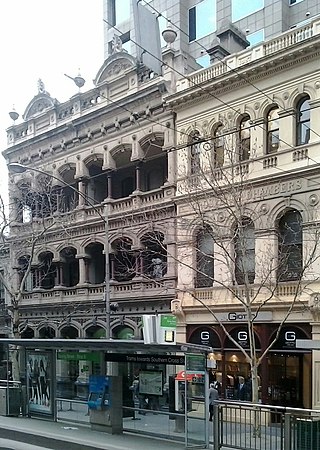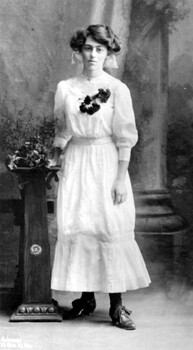
The Victorian Artists Society, which can trace its establishment to 1856 in Melbourne, promotes artistic education, art classes and gallery hire exhibition in Australia. It was formed in March 1888 when the Victorian Academy of Arts and the Australian Artists' Association amalgamated.

The Fitzroy Gardens are 26 hectares located on the southeastern edge of the Melbourne central business district in East Melbourne, Victoria, Australia. The gardens are bounded by Clarendon Street, Albert Street, Lansdowne Street, and Wellington Parade with the Treasury Gardens across Lansdowne street to the west.

Clara Southern was an Australian artist associated with the Heidelberg School, also known as Australian Impressionism. She was active between the years 1883 and her death in 1940. Physically, Southern was tall with reddish fair hair, and was nicknamed 'Panther' because of her lithe beauty.

Grosvenor Chambers, at number 9 Collins Street, Melbourne, contained the first custom-built complex of artists' studios in Australia.
Teisutis 'Joe' Zikaras was an Australian sculptor born in Panevėžys, Lithuania. He earned a diploma at the School of Fine Arts, Kaunas, Lithuania, where his father Juozas, creator of Lithuania's famous Liberty statue, was Head. He left Lithuania after its takeover by Russia and spent two years 1946–48 teaching drawing and sculpture at a campus of the École des Arts et Métiers in Freiburg, Germany, an art school for Lithuanian refugees where Aleksandras Marčiulionis was a principal.

Violet Helen Evangeline Teague was an Australian artist, noted for her painting, printmaking and her critical writings on art.

Norma Redpath was a prominent Australian sculptor, who worked in Italy and Melbourne.

The Melbourne Society of Women Painters and Sculptors, established in Melbourne, Victoria in 1902, is the oldest surviving women's art group in Australia.

Lina Bryans, was an Australian modernist painter.

Esther Paterson Gill was an Australian artist, book-illustrator and cartoonist.

Polly Hurry, was an Australian painter. She was a founding member of the Australian Tonalist movement and part of the Twenty Melbourne Painters Society.

Henrietta Maria Gulliver was an Australian artist who specialized in landscape and floral still-life paintings. She was also a florist, horticulturalist and landscape designer.
Dorothy Mary Braund (1926–2013) was an Australian post-war figuration and contemporary feminist artist, whose practice included painting, printmaking and teaching. Braund's extensive career was instrumental in contributing to the Modernist art scene, along with a generation of significant women artists including: Mary Macqueen, Barbara Brash, Anne Marie Graham, Constance Stokes, Anne Montgomery (artist) and Nancy Grant. Braund's first solo exhibition, held in 1952 at Peter Bray Gallery in Melbourne, launched her career and from then on she had consistent shows and exhibitions. Braund has had approximately 29 solo exhibitions and participated in 25 group exhibitions throughout her career. Braund is also a part of the Cruthers Collection of Women's Art.

Christian Marjory Emily Carlyle Waller was an Australian printmaker, illustrator, muralist and stained-glass artist. At 15 she moved to Melbourne, where she studied at the National Gallery School. In 1915 she married fellow-student Napier Waller.

Alice Chapman (1860–1929) was an Australian artist known for her portraits and genre paintings. Her oeuvre also included, amongst other subjects, still life paintings.

Mabel Pye was an Australian artist noted for painting and printmaking.
Clive Travers Stephen was an Australian sculptor, painter in water-colour and oils, printmaker, and medical doctor.
Alexander Colquhoun was a Scottish-born Australian painter, illustrator and art critic.

Orlando Henry Dutton was an English-born Australian monumental, figurative and architectural sculptor.
The Sculptors’ Society of Australia was formed in 1932 and ceased its activity with the onset of WW2, in 1939.
























